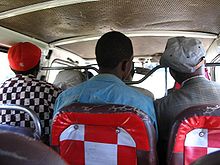- Matatu
-
In Kenya and neighboring nations matatu are privately owned minibuses although pick-up trucks were in the past pressed into service as these East African share taxis.[1] Often decorated, many matatu feature portraits of the famous or slogans and sayings, some religious.[2]
These minibuses ply set routes, run from termini, and are used for both inter and intra-city travel.[3] In addition to a driver, matatu may be staffed by a conductor.[4]
As of 1999 they were the only form of public transport available in Nairobi, Kenya, although in 2006 and 2008 this was no longer the case.[5] Kampala, Uganda, may only be serviced by minibuses as of 2008.[AICD 1]
Contents
Name
The name is a Swahili colloquialism.[6]
Kenyan regulation
In Kenya this industry is regulated, and these minibuses must be fitted with seatbelts and speed governors.[7] The Kenyan regime has been described as having extensive regulatory controls, and in this country a matatu worker can be pulled from the streets simply for sporting too loud a shirt.[8]
Present regulation may not be sufficient deterrent to prevent small infractions, as even decoration may be prohibited.[9]
As of December 2010, Kenyan Government policy is to phase out minibus matatu in favor of larger, 25+ seat buses. It could take ten years to clear the minibus from Nairobi streets, however.[10]
Ugandan regulations
As of 2008, Kampala, Uganda, has no independent transport authority.[AICD 2]
References
- ^ For Kenya and neighboring nations, see Kenya's Taxi Vans Are Packed and Perilous nytimes.com, April 24, 1988
- For private ownership, see In Nairobi, Kenya puts brakes on its runaway success csmonitor.com, June 28, 1999
- For matatu as minibuses, see Kenya (page 383) Tom Parkinson, Max Phillips, Will Gourlay. Lonely Planet, 2006. 416 pages. 1740597435, 9781740597432. (Google Books)
- For past use of pick-up trucks, see Have You Ever Taken A Matatu? glpinc.org
- ^ For portraits, see Nairobi Today: the Paradox of a Fragmented City; Hidden $ Centz: Rolling the Wheels of Nairobi Matatu. Mbugua wa-Mungai. (page 376) edited by Helene Charton-Bigot, Deyssi Rodriguez-Torres. African Books Collective, 2010. 404 pages. 9987080936, 9789987080939. (Google Books)
- For slogans and sayings, see Roll over Snoop Dogg, Ocampo is new king of the matatu csmonitor.com, January 29, 2010
- ^ For set routes, see Kenya (page 382) Tom Parkinson, Max Phillips, Will Gourlay. Lonely Planet, 2006. 352 pages. 1740597435, 9781740597432. (Google Books)
- For termini, see Nairobi Today: the Paradox of a Fragmented City; Hidden $ Centz: Rolling the Wheels of Nairobi Matatu. Mbugua wa-Mungai. (page 374) edited by Helene Charton-Bigot, Deyssi Rodriguez-Torres. African Books Collective, 2010. 404 pages. 9987080936, 9789987080939. (Google Books)
- For intra and inter-city travel, see Negotiating social space: East African microenterprises (page 69) Patrick O. Alila, Poul O. Pedersen. Africa World Press, 2001. 353 pages. 0865439648, 9780865439641. (Google Books)
- ^ Nairobi Today: the Paradox of a Fragmented City; Hidden $ Centz: Rolling the Wheels of Nairobi Matatu. Mbugua wa-Mungai. (page 371) edited by Helene Charton-Bigot, Deyssi Rodriguez-Torres. African Books Collective, 2010. 404 pages. 9987080936, 9789987080939. (Google Books)
- ^ For 1999 matatu as sole form of public transport, see In Nairobi, Kenya puts brakes on its runaway success csmonitor.com, June 28, 1999
- For 2006 other forms of public transport available, see Kenya (page 382) Tom Parkinson, Max Phillips, Will Gourlay. Lonely Planet, 2006. 352 pages. 1740597435, 9781740597432. (Google Books)
- For 2008 other forms of public transport available, see Stuck in Traffic; Urban Transport in Africa (page 6) Ajay Kumar & Fanny Barrett. Africa Infrastructure Country Diagnostic in cooperation with the World Bank, January 2008. Draft Final Report.
- ^ Nairobi Journal; Take (On) the Minibuses, if You Dare nytimes.com, April 16, 1996
- ^ Kenya (page 383) Tom Parkinson, Max Phillips, Will Gourlay. Lonely Planet, 2006. 352 pages. 1740597435, 9781740597432. (Google Books)
- ^ For extensive Kenyan regulatory control, see Stuck in Traffic; Urban Transport in Africa (page 14) Ajay Kumar & Fanny Barrett. Africa Infrastructure Country Diagnostic in cooperation with the World Bank, January 2008. Draft Final Report.
- For loud shirts as illegal, see Nairobi Today: the Paradox of a Fragmented City; Hidden $ Centz: Rolling the Wheels of Nairobi Matatu. Mbugua wa-Mungai. (page 376) edited by Helene Charton-Bigot, Deyssi Rodriguez-Torres. African Books Collective, 2010. 404 pages. 9987080936, 9789987080939. (Google Books)
- ^ For regulation as insufficient deterrent, see Nairobi Today: the Paradox of a Fragmented City; Hidden $ Centz: Rolling the Wheels of Nairobi Matatu. Mbugua wa-Mungai. (page 367) edited by Helene Charton-Bigot, Deyssi Rodriguez-Torres. African Books Collective, 2010. 404 pages. 9987080936, 9789987080939. (Google Books)
- For decoration being prohibited, see Nairobi Today: the Paradox of a Fragmented City; Hidden $ Centz: Rolling the Wheels of Nairobi Matatu. Mbugua wa-Mungai. (page 371) edited by Helene Charton-Bigot, Deyssi Rodriguez-Torres. African Books Collective, 2010. 404 pages. 9987080936, 9789987080939. (Google Books)
- ^ New rules to rein in wild sector nation.co.ke, Friday, December 31 2010
- ^ Stuck in Traffic; Urban Transport in Africa (page 6) Ajay Kumar & Fanny Barrett. Africa Infrastructure Country Diagnostic in cooperation with the World Bank, January 2008. Draft Final Report.
- ^ Barrett & Kumar, page 14
See also
- Dala dala
- Tro tro
Categories:- Share taxis
- Public transport in Kenya
- Transport in Kenya
- Kenya stubs
- ^ For Kenya and neighboring nations, see Kenya's Taxi Vans Are Packed and Perilous nytimes.com, April 24, 1988
Wikimedia Foundation. 2010.

